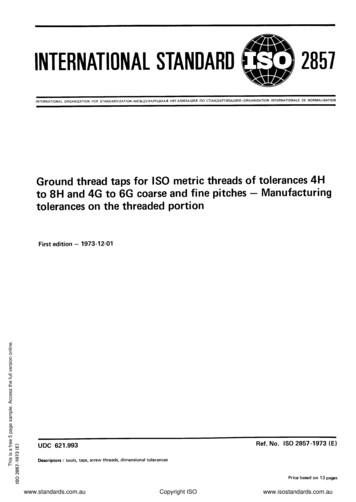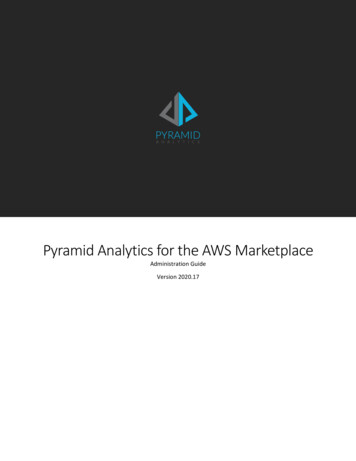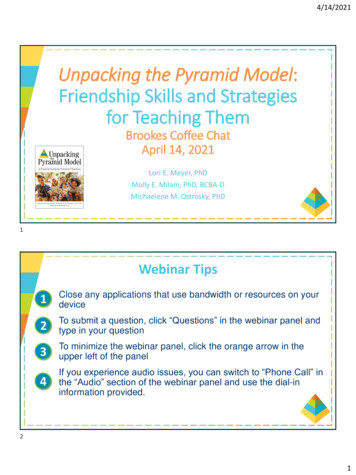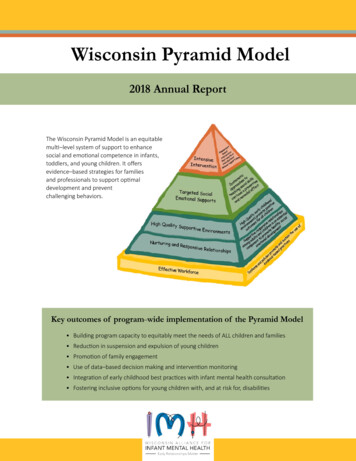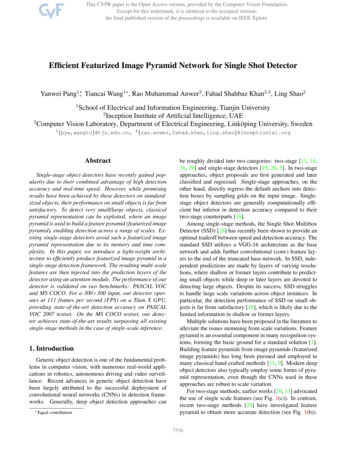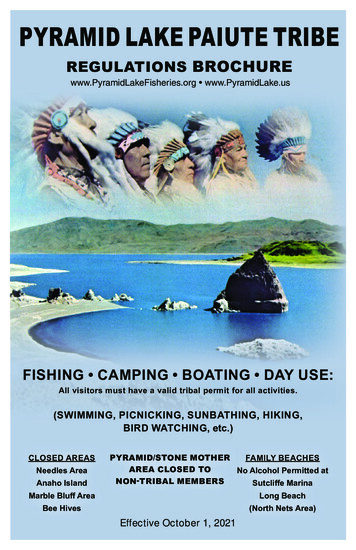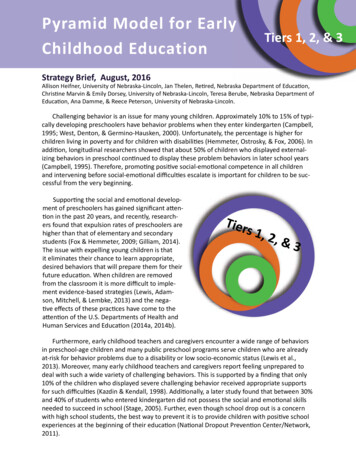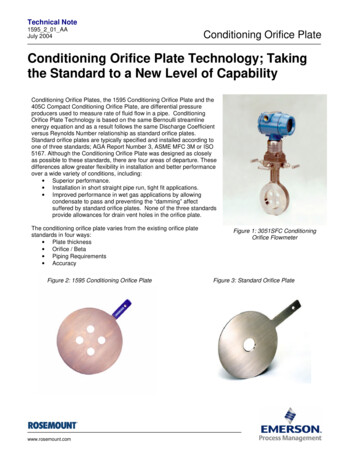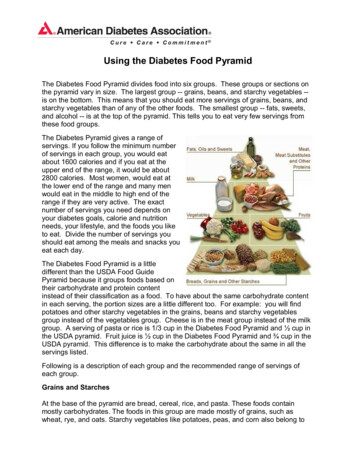
Transcription
Introducing the TAPS pyramid modelThe Teacher Assessment in Primary Science (TAPS) project is a 3 year project based at Bath Spa University and funded bythe Primary Science Teaching Trust (PSTT), which aims to develop support for a valid, reliable and manageable system ofscience assessment which will have a positive impact on children’s learning.Where did this start?Where did this come from?Where do we start?What can we do with this?The Nuffield Foundation (2012)recommended that the rich formativeassessment data collected by teachersin the course of ongoing classroomwork in science should also be made toserve summative reporting purposes.They developed a pyramid model whereassessment information flowed fromclassroom practice to whole schoolreporting – this is represented by theorange arrow.The TAPS project team have worked withlocal project schools, the Primary ScienceQuality Mark and the PSTT College tocreate this model of teacher assessmentand populate it with examples . It can beused as a whole-school self-evaluationtool to support schools in identifyingstrengths and areas for development inschool assessment systems .The ‘Pupil layer’ and the ‘Teacher layer’at the base of the pyramid encapsulatethe principles of Assessment for Learning;schools should begin by focusing onthese layers since this is not only thefoundation of the whole system, it is alsowhere changes will have the most impacton pupil progress in Primary Science.This pdf can be used as a supportivesource of examples and/or as a structureto support school self evaluation. Theinteractive functions allow you to trafficlight your assessment systems (on yourown saved copy) and make notes on theapproaches in your school.Science assessment: school self-evaluation tool NO EVIDENCE SOME EVIDENCEDIRECTION OFINFORMATION FLOWTHROUGH SCHOOL STRONG EVIDENCESCHOOL:DATE:Whole schoolreporting - How dowe support validity andreliability of IVEREPORTINGTeachers summariseachievements in termsof what pupils can do,not only in terms of levels,grades or %S12.MONITORINGOF PUPILPROGRESSTeachers base theirsummative judgements ofpupils’ learning on a rangeof types of activityM11.ONGOINGFORMATIVEASSESSMENTSTARTPupils identify theirexisting ideas, learningneeds and interests, andconsider those of peers.P1M2Teachers planopportunities toelicit pupils’ scienceknowledge and skillsT1Teachers take part inmoderation/discussionwith each other of pupils’ workin order to align judgementsTeachers involve pupilsin discussing learningobjectives andcriteria for successT2Pupils focus on scienceknowledge, understanding,skills and attitudes inlearning objectives andsuccess criteriaP2FEEDBACK FROM DIALOGUE WITH SCHOOLLEADERSHIP, GOVERNORS AND PARENTS INFORMSCHANGES TO SCIENCE ASSESSMENTParents/carers receive oraland written reports thatidentify the next steps fortheir childrenS2Summaries of pupilprogress across thecohort draw on a rangeof informationS3Pupils are aware of thecriteria by which their workover a period of timeis judgedThere is a sharedunderstanding ofprogression in scienceM3M4Teachers gather evidenceof their pupils’ learningthrough questioning/discussion andobservationTeachers gatherevidence of theirpupils’ learning throughstudy of the products ofactivities and tasksT3T4Pupils assess their ownideas and work againstknown criteriaP3M5Teachers useassessment to advancepupils’ learning byadapting the pace,challenge andcontent of activitiesT5Pupils assess peers’ ideasand work against knowncriteriaP4Produced by the Teacher Assessment in Primary Science Project, Bath Spa University, developed from the Nuffield Foundation (2012) and Harlen (2013)A manageable systemfor record-keeping is inoperation to track and reporton pupils’ learning in scienceTEACHERPUPIL/PARENTCONFERENCESINCLUDE DIALOGUEON ATTAINMENTIN SCIENCEOn the pyramid page, each box will takeyou to examples if you click on it. The‘back to the top’ button (bottom right)will take you back to the pyramid. Eachbox on the pyramid has buttons for red,amber, green and reset (if they are blackin Adobe try clicking ‘Highlight existingfields’ on the toolbar). There is a page formaking notes about your own school atthe end of the document and a link forthis on each page. If you prefer to do thison paper then a black and white pyramidfor printing is also available on the PSTTwebsite.Teachers use assessmentto advance pupils’learning by givingfeedback to studentsabout how to improveT6Teachers use assessmentto advance pupils’learning by providingtime for students toreflect on and assesstheir own workT7Pupils use assessment toadvance their learning byacting on feedbackP5Pupils collaboratively (withpeers/teachers) identifynext steps in learningP6SAVE MY PROGRESSNext page If you would like to offer further examplesor provide the TAPS team with feedback,please emailprimary.science@bathspa.ac.ukNext page
TAPS pyramid model: science assessment school self-evaluation tool NO EVIDENCE SOME EVIDENCEDIRECTION OFINFORMATION FLOWTHROUGH SCHOOL STRONG EVIDENCESCHOOL:DATE:Whole schoolreporting - How dowe support validity andreliability of IVEREPORTINGTeachers summariseachievements in termsof what pupils can do,not only in terms of levels,grades or %S12.MONITORINGOF PUPILPROGRESSTeachers base theirsummative judgements ofpupils’ learning on a rangeof types of activityM11.ONGOINGFORMATIVEASSESSMENTPupils identify theirexisting ideas, learningneeds and interests, andconsider those of peers.P1M2Teachers planopportunities toelicit pupils’ scienceknowledge and skillsT1Teachers take part inmoderation/discussionwith each other of pupils’ workin order to align judgementsTeachers involve pupilsin discussing learningobjectives andcriteria for successT2Pupils focus on scienceknowledge, understanding,skills and attitudes inlearning objectives andsuccess criteriaP2FEEDBACK FROM DIALOGUE WITH SCHOOLLEADERSHIP, GOVERNORS AND PARENTS INFORMSCHANGES TO SCIENCE ASSESSMENTParents/carers receive oraland written reports thatidentify the next steps fortheir childrenS2Summaries of pupilprogress across thecohort draw on a rangeof informationS3Pupils are aware of thecriteria by which their workover a period of timeis judgedThere is a sharedunderstanding ofprogression in scienceM3M4Teachers gather evidenceof their pupils’ learningthrough questioning/discussion andobservationTeachers gatherevidence of theirpupils’ learning throughstudy of the products ofactivities and tasksT3T4Pupils assess their ownideas and work againstknown criteriaP3M5Teachers useassessment to advancepupils’ learning byadapting the pace,challenge andcontent of activitiesT5Pupils assess peers’ ideasand work against knowncriteriaP4Produced by the Teacher Assessment in Primary Science Project, Bath Spa University, developed from the Nuffield Foundation (2012) and Harlen (2013)A manageable systemfor record-keeping is inoperation to track and reporton pupils’ learning in scienceTEACHERPUPIL/PARENTCONFERENCESINCLUDE DIALOGUEON ATTAINMENTIN SCIENCETeachers use assessmentto advance pupils’learning by givingfeedback to studentsabout how to improveT6Teachers use assessmentto advance pupils’learning by providingtime for students toreflect on and assesstheir own workT7Pupils use assessment toadvance their learning byacting on feedbackP5Pupils collaboratively (withpeers/teachers) identifynext steps in learningP6SAVE MY PROGRESSNotes Next page
PUPIL BOX 1:PUPILS IDENTIFY THEIR EXISTING IDEAS, LEARNING NEEDSAND INTERESTS, AND CONSIDER THOSE OF PEERSE.g. mindmaps, annotated drawings, KWL grids, mini whiteboards, post its, talk partners.Group discussion of initial ideasEliciting ideas with sortingKWL gridA group elicitation at the start of lesson can be recordedcollaboratively on large paper or sticky notes. For example, thisY5/6 class consider how materials can change.Giving children objects or pictures to sort can tell you a lotabout their ideas, especially if the categories are chosen bythe children.Ask pupils to consider what they already Know about a topicand what they Want to find out. At a later date, return to thegrid to consider what they have Learnt.For example, when Y1 children sorted food items it led to adiscussion about where pasta comes from.This particular example comes from Active active-assessment-Beacon Rise Primary School, Bristolscience/Collecting individual commentsResponses in classdiscussions can berecorded by teachers,TAs or the pupilsthemselves. Forexample, a this Y3/4class were asked toconsider True/Falsestatements regarding whether materials can be changed(materials included chocolate and sugar). The TA recordedresponses during the whole class feedback.Holt Primary School, Wiltshire1.11 Pupil box 1 - p1 of 2St Paul’s Catholic Primary School, YateVictoria Park Primary School, BristolOngoing formative assessmentNotes Previous pageNext page Next box Back to top
Positive, Minus, InterestingPre and post unit thought showersGroup discussion can be structured by PMI: listing the Positivepoints, Minus points and the Interesting effects of a particularsituation. This is one of a range of strategies for ‘Bright IdeasTime’. For further details and other examples see Bright-Ideas-Time/At Northbury Primary children complete Pre and post unit thought showers for each topic. For example, at the beginning of theY3 unit on Plants the child described factors which affect plant growth. At the end of the unit the child described photosynthesisand reproduction.This could be in response to a question like: what if there wasno friction? What if I had an ear in the middle of my hand?‘I like it because you get time to thinkand to get ideas off of other people.’Y3 child‘I like that when you do it you can work with apartner and you are not working on your own.’Yr 3 child‘I like it because you only have to write notesand you have time to rest and to think.’Yr 3 childStaff now use this communication technique in othercurriculum areas such as Geography, History and Literacy.Burford School, Marlow1.11 Pupil box 1 - p2 of 2Northbury Primary School, BarkingOngoing formative assessmentNotes Previous pageNext page Next box Back to top
PUPIL BOX 2:PUPILS FOCUS ON SCIENCE KNOWLEDGE, UNDERSTANDING, SKILLSAND ATTITUDES IN LEARNING OBJECTIVES AND SUCCESS CRITERIA.E.g. be clear about science focus rather than presentation etc.Worlebury St Paul’s CofE VAPrimary SchoolThese success criteria for designing a ‘perfect habitat’ for asmall animal were generated by the children through a wholeclass discussion.Could some have been bracketed together to simplify the list?Could some have been expanded upon?Worlebury St.Paul’s Primary School, Weston-super-Mare1.12 Pupil box 2 - p1 of 1Homework Learning LogsFocus on science objectivesAt Burford School Learning logs enable parents to becomeinvolved in their children’s science learning.By using talk partners and a challenging creature, the focus ison discussion, question raising and explanation:Learning log tasks have allowed children to demonstrate theirknowledge and skills in a variety of ways.What do you think it could be? Why?Cleapps competitionFor learning loghomework, childrenwere asked to make amodel of a sycamoreseed. Best entrieswere presented in anassembly and enteredin the competition.Children are invited to consider the effect no electricitywould have on their day.Burford School, MarlowOngoing formative assessmentNotes Ashley Down Schools, Bristol Previous pageNext page Next box Back to top
PUPIL BOX 3:PUPILS ASSESS THEIR OWN IDEAS ANDWORK AGAINST KNOWN CRITERIAE.g. traffic lighting or highlighting objective, commenting on whether predictions are supported.Making self assessment part ofthe lessonChildren are asked to decide whether they have metthe objective.For example, initials on the board when you have Stand on a chair if you have Malcolm Sargent Primary School, Stamford1.13 Pupil box 3 - p1 of 2Self assessment in a floorbookRAG for self assessment‘Sometimes we get children to record their initial ideas in afloor book. They can then revisit this at the end of a lessonor topic to review how their understanding has developed.Generally at the end of a lesson they would have theopportunity to say how they felt their learning went. They’dusually mark it with a coloured dot, like a traffic light, or asmiley face, and peer assessment we do sometimes get themto mark their own work. We will give them a set of criteria sothey might give like a mark for the presentation, a mark if theygave a reason for their prediction, or something like that, anda mark for using scientific vocabulary.‘Children record Red/Amber/Green at the endof the lesson to showhow they feel about theLearning Objective.Ashley Down Y5Reflecting on predictionsChildren made predictions about what will float/sink. Aftertesting the objects they then used colour to show whethertheir predictions were accurate or not.Ashley Down Y1Oaktree Primary School, SwindonOngoing formative assessmentNotes Ashley Down Schools, Bristol Previous pageNext page Next box Back to top
End of unit self assessmentSelf assessment of attitudes to SciencePupils complete a self assessment sheet at the end of a unit.They make judgements about whether they have achievedthe unit objectives, e.g. I can describe the difference betweena magnet and a magnetic material.A self assessment of how you feel about science using a ‘blob’ diagram (www.blobtree.com).Children select the one they identify with.They also comment on their favourite part of the topic andthe most interesting thing they have learnt.St Peter’s Primary School, Stoke-on-TrentNorthbury Primary School, Barking1.13 Pupil box 3 - p2 of 2Ongoing formative assessmentNotes Previous pageNext page Next box Back to top
PUPIL BOX 4:PUPILS ASSESS PEERS’ IDEAS ANDWORK AGAINST KNOWN CRITERIAE.g. comment on another group’s presentation, give 2 stars and a wish for piece of work.Responding to peer feedbackIn a Year 5 lesson on Space the children were physicallymodelling the orbit of the Earth and moon using differentsized balls. As they moved the balls they gave a commentaryon what was happening, which was then peer assessed forclarity and accuracy. The groups gave advice to each otherfor how to improve their explanation to ‘become 5* scientistswho use scientific vocabulary accurately’.Peer assessmentPupils evaluate their own and other’s work. E.g. deciding howeffective their posters were at teaching others about seeddispersal.Drove Primary makes use of peer assessment to evaluatelearning against known criteria and inform next steps. Thefollowing examples are drawn from peers annotating eachother’s work:‘I like your explanation about dissolving and yoursentence about the liquid dissolving the powder.Improve: maybe label the other two jugs in the picturebecause I don’t know what’s in them.’(Peer feedback)This exemplifies assessment at Shaw: a clear framework forprogression which is shared and used by both staff and pupils,enabling assessment to be used FOR learning.‘I like K’s technicalvocabulary likepollination. The labelsare clear and go in thecorrect order.’(Peer feedback)Shaw Primary School, Melksham1.14 Pupil box 4 - p1 of 1Ongoing formative assessmentNotes Drove Primary School, Swindon Previous pageNext page Next box Back to top
PUPIL BOX 5:PUPILS USE ASSESSMENT TO ADVANCE THEIRLEARNING BY ACTING ON FEEDBACKE.g. respond to mini plenary advice in second half of lesson, make improvements in next investigation.Acting on feedbackReturning to a taskAt Shaw a high emphasis is put on speaking, listening andgroup work. This is combined with a focus on self and peerassessment in many lessons.Here a pupil has completed a task, the teacher has givenfeedback and the pupil has had another go.For example, in Year 4 the children had found it difficult tocreate a branching key in their books, so the next lessonbegan with pupils making keys with ‘post its’ in small groups.After talk partners had formulated yes/no questions todivide the animals, the children identified for themselvesif they felt confident or not, with those who found it trickybeing placed with those who did not.After ten minutes creating their own keys, the pupils weregiven time to walk around to look at others’ work. Rather thanthe teacher picking out good ideas, these were put forward bythe pupils who then went back to improve their key.The pupil had started by drawing arrows around the world,after discussion with the teacher, the pupil then drew newarrows towards the centre of the Earth. This particularexample comes from Active Assessment: ssment-science/Shaw Primary School, MelkshamPupils make improvements in responseto suggestions givenComments made by observer:At the start of the lesson children reviewed feedbackcomments made by teacher on work from previous lesson[Time was given to pupils to do this, and pupil responses tocomments made were encouraged – written or oral]During the lesson adult intervention led to improvementsparticularly in recording of results.St. Andrew’s Primary School1.15 Pupil box 5 - p1 of 1Ongoing formative assessmentNotes St Paul’s Catholic Primary School, Yate Previous pageNext page Next box Back to top
PUPIL BOX 6:PUPILS COLLABORATIVELY (WITH PEERS/TEACHERS)IDENTIFY NEXT STEPS IN LEARNINGE.g. identify which part of the success criteria is missing, consider how to make the measurement more accurate.Target cards at Crosshall JuniorsIdentifying next stepsChildren are given a Target Card which shows a clear LearningJourney for each topic.Children put forward ideas for what they would like to learnnext. For example, pupils can put their questions and querieson a class Wonder wall:They self assess at the beginning and end of each topic.IMPACTChildren are challenged and supported in relevant ways.Children are encouraged to take ownership of their learning.- Facts we want to check.- Things we want to find out.Individual next step cards can remind the children of a currentfocus. The example here includes capital letters for English,times tables for Maths and using observations for Science.Crosshall Junior Academy Trust, St. Neots1.16 Pupil box 6 - p1Holt Primary School, WiltshireOngoing formative assessmentNotes Previous pageNext page Next box Back to top
TEACHER BOX 1:TEACHERS PLAN OPPORTUNITIES TO ELICIT PUPILS’ SCIENCEKNOWLEDGE AND SKILLSE.g. plans show range of elicitation strategies at variety of times E.g. beg/mid/end lesson.Pre and post assessmentsTeachers find out what the children know at the start andthe end of the topic. This helps to pitch the lessons and alsoclearly demonstrates progress.For example, in a year 1 group discussion about animals,at the beginning of the topic the children knew little aboutamphibians or invertebrates. By the end of the unit, thechildren could name animals in these groups and describesome of their features.Groups identify existing ideasGroups of children are able to share what they know. Forexample, as a class they list animal groups and features, thengo into groups to list animals of each type.This activity was in preparation to make an animal ‘guesswho’ game. It also gave the teacher a chance to consider thechildren’s understanding of classification and calculate theirnext steps.Shaw Primary School, Melksham1.21 Teacher box 1 - p1 of 3Ongoing formative assessmentNotes Victoria Park Primary School, Bristol - Y2 Previous pageNext page Next box Back to top
At Burford we use interactive displays to celebrate science.Year 6 questions at the beginning of the lesson. Children love sticking up their ideas on the interactive board.As the topic progresses they see how their ideasand understanding change compared to thebeginning of the topic.Post-it notes promote questions and answers.Clip on vocabulary words can be taken downduring the lessons to help with writing.A science display board in the front entrance is updatedregularly and shows that science is valued as a subjectfeaturing ‘Science in the News’ or an ‘Amazing Science Factof the Week’.Real objects are linked to real scientists.Children in Y4 recorded classroomtemperature at different times of the day.1.21 Teacher box 1 - p2 of 3Burford School, MarlowOngoing formative assessmentNotes Previous pageNext page Next box Back to top
Annotated planningTeachers plan opportunities to elicitLesson planning including WALT, success criteria andevidence being looked for AfL.Plan focused group exploration of materials with torches with teacher who writes comments on children’s sheets.Worlebury St Paul’s CofE VA Primary School annotatedmedium term planning showing assessment of both wholeclass and notable individual childrenWorlebury St.Paul’s Primary School, Weston-super-Mare1.21 Teacher box 1 - p3 of 3Ashley Down Schools, Bristol - Y1Ongoing formative assessmentNotes Previous pageNext page Next box Back to top
TEACHER BOX 2:TEACHERS INVOLVE PUPILS IN DISCUSSINGLEARNING OBJECTIVES AND CRITERIA FOR SUCCESSE.g. discuss what good observation or conclusions look like.Discuss the LOLearning objective is the focus throughout the lessonLearning objectives are shared and differentiatedPupils are supported to focus on the learning objective (which is may be different from the ‘title’Eg LO: to set up a fair test, title: how to kill a plant).Eg*I can see how I can use my knowledge of scientificproperties to link to ideasMarking comments draw attention to areas of success eg use of scientific vocabulary.** I can look at data in a pie chart*** I can read about science and tell you how theinformation supported the scientific ideasMalcolm Sargent Primary School, Stamford1.22 Teacher box 2 - p1 of 2Ashley Down Schools, Bristol - Y3Ongoing formative assessmentNotes Previous pageNext page Next box Back to top
Ledbury Challenges .Ledbury differentiated outcomesan example of Year 6 challenges designed tofind out what the children knewY5 Group ActivityCircuit ChallengesCan you draw a diagram of the following circuits?Don’t forget to use a ruler clearly.Ready Make one bulb light up.Steady Make two buzzers work.Go Make 2 bulbs very bright. Then, draw a circuit,which makes 2 bulbs very dim.GoGo Add a switch that turns off both bulbs. Is thisa series or parallel circuit?How can we prove that there are gases around us?Show concept cartoon and explain Wizard Wow’s problem.Explain that Wizard Wow is very clumsy and spills his potions. He needs something that will absorb any spills quickly and effectively.Learning ObjectiveTo know that air existsTo know what solidsdissolve completely inwater.To be able to identify whatmakes a solid absorbliquids successfully.ReadyI can find a way to prove thatair exists.I can identify which solidscompletely dissolved.I can say which solid was thebest at absorbing.SteadyI can also explainmy reasoning.I can also explain why.I can predict with a reasonwhich will be the best.GoI can even find multiple waysto show air exists and givereasoning for each.I can even use the termstransparent, translucentand opaque to explain myreasoning.I can even explain my resultsusing scientific reasoning.AssessmentSuperSonic Add a switch that turns off only one bulb.Is this a series or parallel circuit?The “ready, steady, go” criteria help children to upgrade their work by giving them clear targetsLedbury Primary School, Herefordshire1.22 Teacher box 2 - p2 of 2Ledbury Primary School, HerefordshireOngoing formative assessmentNotes Previous pageNext page Next box Back to top
TEACHER BOX 3:TEACHERS GATHER EVIDENCE OF THEIR PUPILS’ LEARNINGTHROUGH QUESTIONNING/DISCUSSION AND OBSERVATIONConcept Cartoons for FormativeAssessmentAt Ledbury we began to use Concept cartoons as startingpoints to stimulate discussion and investigation. We gatheredchildren’s ideas and encouraged them to think about howthey could investigate to find a solution.In Year 5, children used the concept cartoon about thesnowman to help them think about how best to insulate theirmagic potions as part of their magical materials topic. In Y2the children used a similar cartoon to help them solve theproblem of how to stop the dinosaur eggs from melting.As a ‘cold’ task to find out what children already knowabout a topic As an assessment tool to find out what children have learnt By making their own to fit to a specific topic To generate questions about a topicTeachersConcept cartoons are ace. As a teacher they give me astarting point to go from.I think they can be used in different ways and not just forscience, for other subjects too!Concept cartoons evolved as teachers began to use them indifferent ways: Using concept cartoons:Great for getting the children thinking about the subjectand trying to formulate their own ideas.They are great for assessment and for using scientificlanguage.I love the concept cartoons as a tool for learning and asupport for teaching.Children can refer back to them as they refine their ideas.They open up the lesson making the children more incontrol of the direction of learning.See conceptcartoons.com for further information.Ledbury Primary School, Herefordshire1.23 Teacher box 3 - p1 of 3Ongoing formative assessmentNotes Previous pageNext page Next box Back to top
Using observationsRecording discussionWe decided to build in challenges and up-levelled tasks toprovide more differentiation. We modelled observationsleading to next steps based on good practise in EYFS.Ipads can be used to capture discussions with children.For example, Soundcloud can be used to record children’sinitial ideas, capture group reflections on what they havediscovered, or provide an opportunity for children to listenback and reflect on their progress.Research on recording assessment ‘In the Thick of It’ isbased at Manchester University’s Science and EngineeringEducation Research and Innovation Hub http://www.fascinate.manchester.ac.uk/projects/ onTeachers use a class list and use a triangle symbol as aquick way to record what is observed in a lesson, throughdiscussion or in work. The amount of triangle drawn indicateshow well the child is meeting the objective (from 1 line to3 lines). After the lesson the teacher decides if a child hasachieved the level, partially achieved it or achieved above it.This information is then used to plan the next steps for thedifferent groups of children.Ledbury Primary School, Herefordshire1.23 Teacher box 3 - p2 of 3Great Moor Infant School, Stockport - Class 1Ongoing formative assessmentNotes Previous pageNext page Next box Back to top
Recording discussion in floorbooksTeachers gather evidence through classdiscussionA teacher or TA scribes the children’s comments in response to a stimulus eg magnetic materials.Class discussions: ideas gathered on paper or electronicflipchart, names next to ideas.This recording takes place in a group or class book which creates a record of how the children’s ideas have developed.For further information on how to use floorbooks go essional-development/floorbooks.aspxShaw Primary School, Melksham - Y11.23 Teacher box 3 - p3 of 3Ongoing formative assessmentNotes Ashley Down Schools, Bristol - Y1 Previous pageNext page Next box Back to top
TEACHER BOX 4:TEACHERS GATHER EVIDENCE OF THEIR PUPILS’ LEARNINGTHROUGH STUDY OF THE PRODUCTS OF ACTIVITIES AND TASKSE.g. any recording, models, sortingApplying knowledge at Forres PrimaryModel makingAt Dame Bradbury we have experimented with modelmaking as a learning and recording strategy - a method thatdifferentiates by outcome, but is fully accessible to all children.Children consider why the statues might be crumbling whenit rains - are they really made of marble?Child’s work:I think it’s chalk because marble is impermeable but chalk ispermeable. Marble does not wear away but chalk wearsaway easily.Child’s work:I think it’s chalk because marble is impermeable but chalk ispermeable. Marble does not wear away but chalk wearsY5 children modelled the structure of the ear using plasticine.They used whiteboard pens directly onto the Science tablesto label their models.away easily.Forres Primary School, Hoddesdon1.24 Teacher box 4 - p1 of 3Ongoing formative assessmentNotes Y4 children made model skeletons at home. They had toresearch and choose their skeleton, materials and labellingmethod. The models were displayed at school and thechildren self assessed their work.Dame Bradbury’s School, Saffron Walden Previous pageNext page Next box Back to top
Evidence of learningEvidence of learning can be individual (on left) or as part of a group (on right). Plus that which is not written down eg acting out/modelling seed dispersal.Burscough Village Primary School, Lancs - Y31.24 Teacher box 4 - p2 of 3Ongoing formative assessmentNotes Previous pageNext page Next box Back to top
Structuring evidenceGathering evidence of children’s learningRecording in a range of ways at LedburyEvidence that a child understands how to connect up a bulbwith a battery to make it lightA ‘post it’ investigation planner under construction.As a result of feedback from children we explored differentways of recording to make it more manageable and lessonerous.The finished planner can be photographed as evidence of agroup’s understanding of science investigation planningCreating play dough animals and explaining their adaptations.Y3 demonstrated what theyhad been learning about duringtheir assembly for parents. Theyperformed a dance to explainhow rocks are formed andtalked about different types ofrocks and their uses.Worlebury St.Paul’s Primary School,
This pdf can be used as a supportive source of examples and/or as a structure to support school self evaluation. The interactive functions allow you to traffic light your assessment systems (on your own saved copy) and make notes on the approaches in your school. On the pyramid page, each box will take you to examples if you click on it. The


